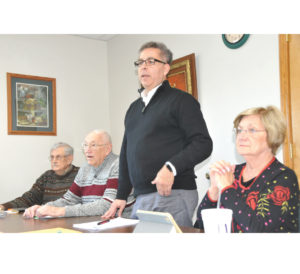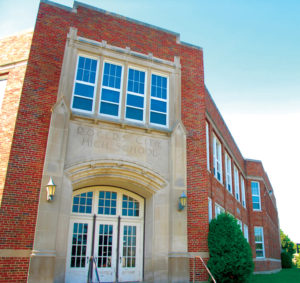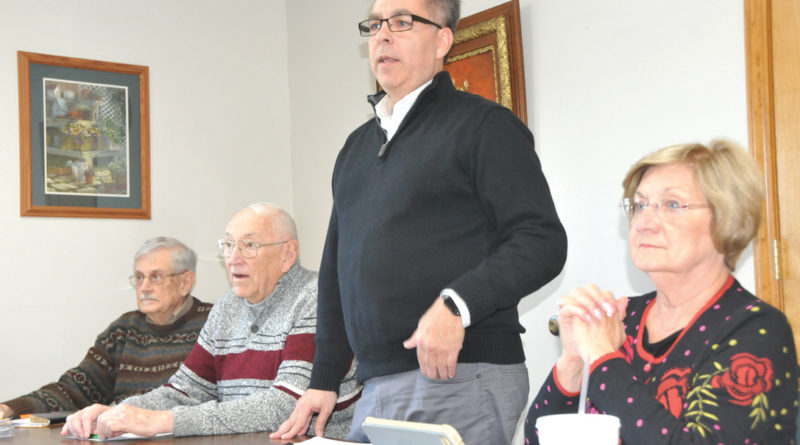‘It’s a gem in Rogers City, don’t tear it down,’ says architect about Grambau Center
by Peter Jakey–Managing Editor
There was a standing-room only crowd that attended the April meeting of the Presque Isle District Library (PIDL) in the Avery Johnson room.
Usually, the board conducts its monthly regular meetings in relative obscurity, but this is the month the Grambau Education Center (GEC) finally made it on the agenda.
The cramped meeting room was an example of the space issue at the Rogers City headquarters.
Because two other community programs were scheduled in the adjacent Constance Jordan conference room, that is nearly twice the size, the much-anticipated board meeting regarding the future of the GEC could not be moved.

The library board and its director have expressed a genuine interest in becoming the next tenant of the historic former school building at the corner of North Fourth and West Huron.
It’s going to take the assistance of Presque Isle County taxpayers to provide the $8 million in renovations to upgrade the beloved brick structure. There also would be about a half a million dollar operational millage. It would be one mill for renovation and another mill for operations. No ballot date has been scheduled, although August was targeted, there may not be enough time.
C2AE owner/architect, Dennis Jensen, of Grand Rapids has been working closely with the library board about what it is going to take to renovate.
“They (C2AE officials) came up late last fall and took a tour of the building and gave of us some ideas of what the status of the building is and what potential it could show for the library,” said PIDL board chairman Jeff Hopp, who then gave the floor over to Jensen.
“A lot of the work that we do is looking at repurposing older buildings for libraries as well as other uses,” said Jensen in his opening remarks. “So, it fits into our wheelhouse real well.”
Because it has been unheated, said Jensen, “some of the cold has done a little bit of damage inside, but for most purposes, it’s really well-constructed and is still in great shape.
“Looking at many structures in my career, where a potential library could go, I think it is a great fit.” He said there is enough room for parking on the old playground in back.
“We could certainly beautify the neighborhood a little bit and probably improve property values, too.”
Jensen said that an old educational building being converted to a library has to be brought up to code.
“So, that’s why some of the costs are where they are,” said Jensen. “It’s still a lot cheaper than building a new building.
“Also, it’s a gorgeous building. We run into a lot of buildings that are very suitable, practical, but nothing like this that looks so nice.” He said the main floor is designed for a capacity for 150 pounds per square foot for books and sh elving. The second floor would be more suited for offices and meeting rooms.
elving. The second floor would be more suited for offices and meeting rooms.
Jensen also said the former schoolrooms could stay the same.
Hopp asked Jensen to explain the option of a bond issue.
“Have a bond issue, raise taxes temporarily…but we like to see that augmented with a capital campaign,” said Jensen. “Typically, if you are going to the voters for a request, if you could offset those costs with 10 to 15 percent in the bank, that always helps out a lot.”
PIDL director Amber Alexander is looking to bring a capital improvement plan before the board next month. “It would be one of our first steps going forward,” said Alexander.
“Every year (GEC) sits idle it decays to some degree,” said board member Beach Hall. “At what point does it need to be demolished?”
Jensen relayed a story about a former high school building in Lapeer that sat vacant for a dozen years. “It’s beyond the point of saving, now, which four or five years ago could have been saved. Very similar school, similar construction, built in the same timeline.”
Jensen suggested turning up the heat to 45 degrees Fahrenheit, “That would be wonderful. That goes a long way of driving the moisture out.” He said it would cost about $6,000 to heat the building per year.
Alexander said a renovation millage, as well as an operational millage would go hand-in-hand.
Rogers City Area Schools board of education president Devin Pommerenke was given time to speak and said the board had the first reading of a policy change that would allow the district to dispose of real property, “in any manner that we see fit or for the good of the community. We are on board with this and we think this would be good for the community.”
Pommerenke said nobody on the school board wants to see the wrecking ball come to town.
“Fortunately, we heard (Jensen) say, sometimes it has to happen,” said Pommerenke. “We are not there yet, so let’s not go there.”
Pommerenke said the board has obtained a rough estimate to raze the building. “It would be no less than $5 million, which would be a cost on the school,” he added. “Which would be a cost on the community…disposal costs are astronomical.”
He said the value of the vacant property would essentially be “nothing and everybody would be sad.”
Pommerenke said he looks forward to discussing a purchase agreement in the future. However, the purchase of GEC would be contingent on the success of the millage.
“It’s a gem in Rogers City,” said Jensen. “There’s no doubt about it. Don’t destroy it.”

